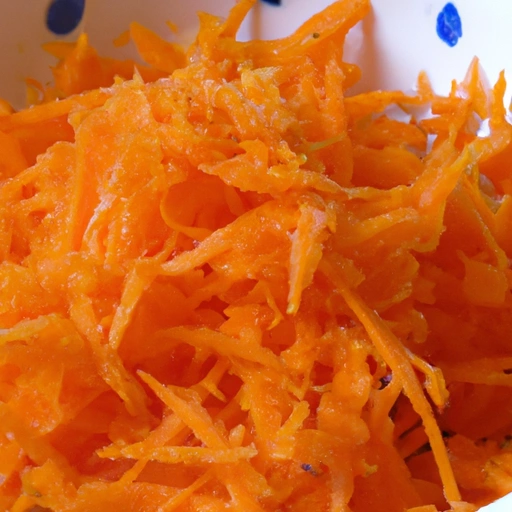Grated Carrot
Description

Grated carrot is a versatile food ingredient made by shredding fresh carrots into fine strips using a grater or food processor. This preparation is commonly used in various cuisines around the world and is known for its sweet flavor, vibrant color, and satisfying crunch. Depending on the recipe, grated carrots can be measured in cups or grams, with common conversions being 1 cup (approximately 110 grams or 4 ounces) or 1 tablespoon (about 7 grams or 0.25 ounces).
Common uses
Grated carrot is widely used as a garnish, a salad component, a baking ingredient, or even a primary vegetable in numerous dishes. It is often found in coleslaws, carrot cakes, muffins, and salads, where it contributes a sweet flavor and moist texture.
Nutritional value
Calories
Grated carrot is low in calories, with about 45 calories per 100 grams (3.5 ounces).
Protein
It contains about 1 gram of protein per 100 grams (3.5 ounces).
Fat
Grated carrot is virtually fat-free, with less than 0.5 grams per 100 grams (3.5 ounces).
Carbohydrates
It has about 10 grams of carbohydrates per 100 grams (3.5 ounces), mainly from natural sugars and dietary fiber.
Vitamins
Carrots are an excellent source of vitamin A in the form of beta-carotene. They also provide vitamins C, K, and B6.
Minerals
They contain minerals such as potassium, manganese, and small amounts of calcium and iron.
Health benefits
Grated carrot offers numerous health benefits. The high vitamin A content supports eye health, while the fiber aids digestion. The antioxidants present in carrots can contribute to a reduced risk of chronic diseases and improve skin health.
Potential risks
While grated carrot is generally safe for consumption, overeating can lead to carotenemia, a harmless condition where the skin turns slightly orange due to high levels of carotene in the body. Additionally, those on a low-carbohydrate diet may need to monitor their carrot intake due to its sugar content.
Common recipes
Grated carrot is featured in a variety of recipes, including carrot cake, carrot-raisin salad, spring rolls, carrot-ginger dressing, and savory dishes like meatloaf and casseroles.
Cooking methods
Grated carrot can be eaten raw, steamed, sautéed, baked, or boiled, making it extremely adaptable to various cooking methods.
Pairing with other ingredients
It pairs well with nuts, such as walnuts and pecans; fruits like raisins and apples; spices like cinnamon, nutmeg, and ginger; and proteins including chicken, beef, and tofu.
Summary
Grated carrot is a nutritious and colorful addition to a plethora of dishes from various cuisines. Its rich historical background and health benefits make it a popular choice for enhancing the flavor, texture, and visual appeal of meals. Whether used in sweet or savory recipes, grated carrot is a staple ingredient that home cooks and professional chefs alike rely on for its versatility and healthful properties.